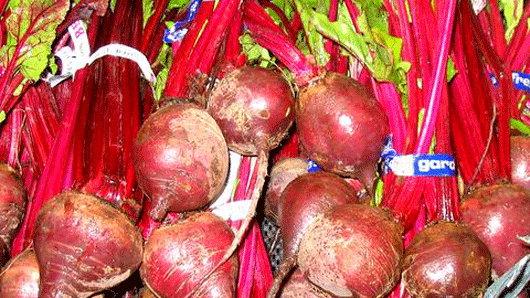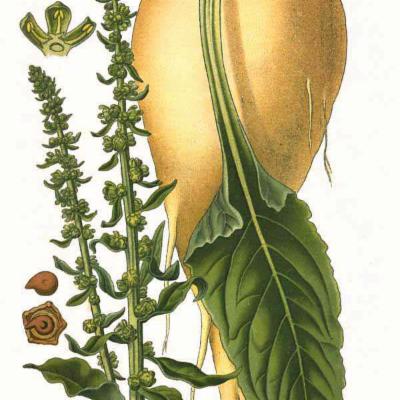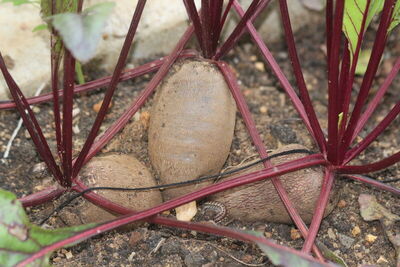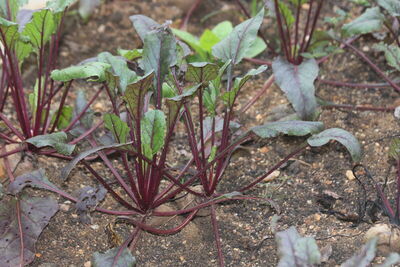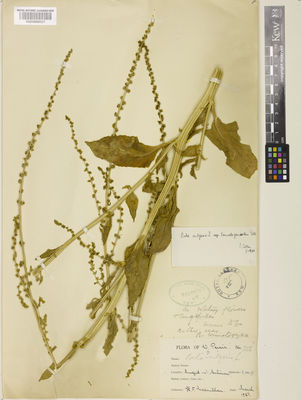Cultivar groups
There are considered to be four major cultivar groups of Beta vulgaris :
Garden beet group (beetroot)
Leaf beet group (rhubarb chard, spinach beet, Swiss chard, silver beet)
Sugar beet group (sugar beet)
Fodder beet group (mangel-wurzel, mangold) Geography and distribution
Beta vulgaris subspecies maritima (sea beet) grows wild along the Atlantic and Mediterranean coasts of Europe, where it is found near the sea shore, particularly in heavy alluvial soils and clays at disturbed sites.
Cultivars of Beta vulgaris are grown throughout Europe and North America.
Description
Overview: A polymorphic biennial (flowering in the second year of growth), up to 2 m tall when in flower.
Leaves: Basal leaves forming a rosette.
Flowers: Small, green, borne in clusters subtended by bracts, forming dense, usually branched inflorescences. Each flower contains two stigmas (female parts).
Fruits and seeds: 'Seeds' are actually fruits that are attached to each other and enveloped in a woody covering (calyces).
Leaf beet cultivar group (rhubarb chard, spinach beet, Swiss chard, silver beet) - root not usually swollen, leaf midrib of some cultivars dark orange or scarlet, lamina sometimes puckered.
Garden and fodder beet groups (beetroot, mangel-wurzel, mangold) - hypocotyl (area just above the root) swollen, plant often flushed red-purple or yellow-white but lamina and inflorescence axis usually green.
Sugar beet - whitish, conical 'roots', up to 50 cm long.
Beta vulgaris subspecies maritima (sea beet) - stem to 80 cm tall, root not swollen, leaves to 10 cm long, flowers in clusters of 1-3.
Uses Food and drink (sugar, root vegetable, leafy vegetable)
Sugar beet is a major agricultural crop throughout Europe and North America, and the most important source of sugar in temperate countries. Sugar beet 'roots' contain up to 20% sugar by weight and have been used for commercial sugar extraction since 1801.
Beetroot is a popular vegetable, eaten boiled, pickled, or grated raw for salads. It is the main ingredient of borscht, a soup of Ukrainian origin. Beetroot juice is marketed as a healthy drink, alone or mixed with other juices.
Spinach beet is cultivated for its succulent leaves, which are similar in flavour to spinach and used in the same way. Cultivars known by the common names seakale-beet, chard, swiss chard and rhubarb chard differ mainly in having a broad, white leaf stalk, which is often eaten as a separate vegetable, while the green blade is used like spinach. Cultivars with reddish-purple, yellow or orange leaf-stalks and blades are available.
Sea beet leaves are one of the most popular wild vegetables in Britain, where the tangy leaves are cooked like spinach.
Livestock feed
Cultivars from the fodder beet group, known by common names such as mangel-wurzel and mangold, are grown specifically as cattle feed. The UK record for the largest recorded 'root' (actually a swollen hypocotyl) is 24.72 kg.
The leafy tops of sugar beet are a good animal feed, as are the root residue and molasses produced during sugar extraction.
Other uses
Molasses produced during the extraction of sugar from sugar beet is used to make industrial alcohol. Filter cake, the residue left behind after the purification of sugar beet juice, is used as manure. Beetroot is used as a natural dye. Sugar beet roots have been proposed as a potential biofuel.
The flavour enhancer monosodium glutamate (MSG) is sometimes produced by bacterial fermentation using carbohydrates from sugar beet molasses.
Cultivars such as Beta vulgaris 'Dracaenofolia', which has narrow, deep scarlet leaves, are grown as ornamentals.
Millennium Seed Bank: Seed storage
The Millennium Seed Bank Partnership aims to save plant life worldwide, focusing on plants under threat and those of most use in the future. Seeds are dried, packaged and stored at a sub-zero temperature in our seed bank vault.
More than 80 collections of Beta vulgaris seeds are held in Kew's Millennium Seed Bank based at Wakehurst in West Sussex.
This species at Kew
Beta vulgaris can be seen growing in the Queen's Garden (behind Kew Palace) at Kew.
Dried specimens of Beta vulgaris are held in Kew's Herbarium where they are available to researchers by appointment. Details of specimens of other Beta species can be seen online in Kew's Herbarium Catalogue.
Specimens of beet seeds, briquettes, pulp and pellets, as well as sugar, paper and insulating boards made from it, are held in Kew's Economic Botany Collection in the Sir Joseph Banks Building, where they are available to researchers by appointment.

